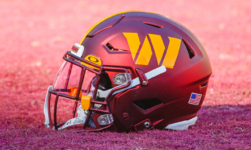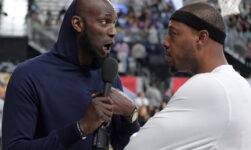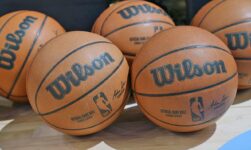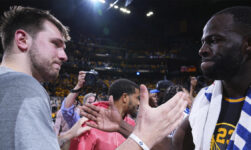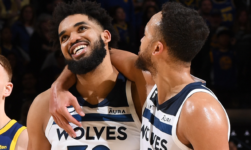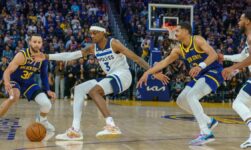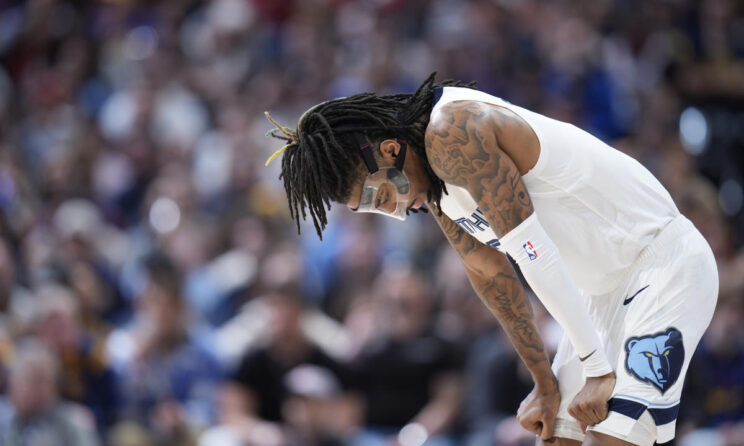
The road to becoming a team of consequence in the NBA unfolds in stages. It typically begins with rubble — the broken-down remainder of the previous era, the discarded misfit pieces left strewn about as a franchise starts the process of creating something new.
Then comes a blueprint for the future and, with any luck, a cornerstone talent around which to build. With the plan and the organizing principle in place, the team begins its climb: from emphasizing development and culture to year-over-year on-court improvement; from approaching the playoffs to making the playoffs to winning in the playoffs.
The Memphis Grizzlies had crossed every one of those stages over the past half-decade, sliding from the sunset of “Grit and Grind” glory days to the growth of a new generation with shocking speed. They entered this season as one of the NBA’s most fascinating teams: a rising power with a highlight-reel offense and snarling defense, featuring a trio of complementary young stars who only promised to get better. But with success comes pressure — to not only replicate the 50-plus wins and playoff series victories, but to build on them, to win more, to win bigger.
This is the kind of pressure Memphis now feels, and — in the midst of a dismal stretch that has featured fits-and-starts play on the court and significantly more worrisome issues off of it — it threatens to undercut the championship chase of one of the NBA’s most dynamic young teams. With just five weeks left in the season, the Grizzlies find themselves at what sure feels like a moment of truth. Where do they go from here?
All discussion of Memphis right now understandably centers on Ja Morant, and on the string of stories surrounding him that has advanced from months of simmering off-court static to more than enough noise to prompt real concern and require immediate address.
The tipping point came early Saturday morning. Just a few hours after the Grizzlies’ Friday loss to the Nuggets — and only a few days after Morant’s representatives responded to a Washington Post report detailing multiple recent confrontations in which he was involved by asserting that “any and every allegation involving a firearm has been fully investigated and could not be corroborated” — there was Morant, streaming himself partying on Instagram Live at a strip club, and holding what appeared to be a gun.
Story continues
Morant has stepped away from the Grizzlies, in what may or may not be a proper suspension, to “get help and work on learning better methods of dealing with stress and my overall well-being,” as he put it in a statement. He wasn’t with the team for Sunday’s loss to the Clippers. He won’t be with them for Tuesday’s game against the Lakers. And, at this point, it’s unclear exactly when he’ll be with them again.
Memphis Grizzlies guard Ja Morant is away from the team for an undetermined amount of time, and the franchise faces a turning point on the court while its star figures out things off it. (AP Photo/David Zalubowski)
Head coach Taylor Jenkins told reporters on Sunday there is “no definitive timeline” for Morant’s return. Shams Charania of The Athletic reported Monday the Grizzlies are “pretty much expecting that this is going to be a little bit here” while Morant seeks help. The NBA and Glendale, Colorado, police are both investigating the incident — raising the specter of additional league discipline, legal issues related to firearm possession, or both.
At the risk of stating something so obvious as to be self-evident: Nothing on the court matters a scintilla as much as Morant finding healthy and safe ways to manage the myriad pressures that come with his personal and professional position, and walking away from potentially dangerous ones before reaching the point of no return. And if that process takes time, well, so be it. Morant’s 23, and the Grizzlies have committed to him for the next five years as the focal point and signature star of their franchise; as Chris Herrington wrote in The Daily Memphian, “Whatever [Morant’s situation] means for the weeks ahead … matters less than getting this right.”
The weeks ahead do still matter, though, and the Grizzlies — who’ve gone 7-12 since the 11-game winning streak that had them atop the West in mid-January — now enter a critical stretch without their offensive engine. Memphis has lost six of the 10 games Morant hasn’t suited up for this season, including Sunday’s loss to the Clippers. The good news: The Grizz have outscored opponents by 1.8 points per 100 possessions with Morant off the floor, according to Cleaning the Glass. The bad news: They’ve been carried largely by their defense in those minutes, scoring at bottom-10 levels without their All-NBA playmaker.
Tyus Jones, arguably the NBA’s best backup point guard, just about always steps up when pressed into service in Morant’s stead; true to form, he popped for 25 points on 9-for-14 shooting with 12 assists and five steals against the Clippers. But even with Jones’ steady hand at the wheel, and with the likes of Desmond Bane, Jaren Jackson Jr. and Dillon Brooks all capable of taking on a greater share of the scoring burden, an extended absence for Morant over the final few weeks of the regular season would be a major blow for Memphis … especially since it’s not the only absence they’re dealing with.
The same day that Morant’s Instagram Live escapades began making the rounds, the Grizzlies learned that Brandon Clarke — the ace reserve who had to be helped off the court after suffering a non-contact injury against Denver — had ruptured the Achilles tendon in his left leg.
That’s devastating news for Clarke, a 26-year-old just entering his prime who contributes on both ends with his athleticism and explosiveness, and who must now grind through a grueling rehab process, thinking about a return date that must seem impossibly far away. A 2019 analysis of Achilles tears by Jeff Stotts of In Street Clothes pegged the average return-to-play time frame for NBA players at just under 10 months. A similarly styled player, Dallas’ Dwight Powell, missed about 11 months after his 2020 rupture; he’s remained productive since his return in an analogous role, as a high-usage/low-efficiency big man who sets screens, dives to the basket and protects the rim on defense.
But even if something like a full return to form is in the cards for Clarke — a distinct possibility in an era where Kevin Durant and Klay Thompson are still playing like stars years removed from their ruptures — he won’t set foot on the court again for the Grizzlies until midway through next season at the earliest. Which means Memphis isn’t only without its leading scorer and assist man, but also its first big off the bench — its most effective interior finisher, its best roll man, one of its best offensive rebounders and a havoc-wreaking defender with the strength and quickness to guard across the positional spectrum.
Clarke’s relentlessness on the offensive glass was a major factor in the Grizzlies’ playoff victory over the Timberwolves last spring. His ability to slot in alongside Defensive Player of the Year favorite Jackson in a fast and fearsome frontcourt pairing that has blitzed opponents over the past two seasons has helped unlock Memphis’ best lineups. With Clarke on the floor, the Grizzlies have scored more effectively in the half-court and gotten out in transition more often while remaining stout and versatile defensively; without him, a team that desperately needs more pathways to easy buckets now has fewer, and will probably be forced to find out how sophomore Santi Aldama stands up to postseason questioning on the defensive end.
The healthy return of Steven Adams — which, given that he’s now playing 5-on-5, seems to be on the way — should help on that front. The bruising center, who has missed the last 17 games with a sprained right PCL, is tied for sixth in the league in second-chance points per game and boasts the highest offensive rebounding rate of any player to log at least 1,000 minutes in a quarter-century. His gift for extending possessions and setting the kind of bone-rattling screens that create open shots for ballhandlers, served with a side of complementary playmaking from the high post, understandably doesn’t draw the same kind of attention as Morant’s poster dunks or Bane’s pull-up 3s, but it’s vital to Memphis’ offensive flow; the Grizzlies have scored 7.3 more points-per-100 with Adams on the court this season than when he’s off it, and rank a disappointing 21st in offensive efficiency since he left the lineup.
But as important as Adams has been on both ends of the floor — Memphis’ defense has been suffocating with the Kiwi clogging the lane, allowing JJJ to teleport all over the half-court to swat shots — his relative plodding can make him a matchup liability against five-out offenses that can spread the floor. That’s why he barely played against Karl-Anthony Towns and Minnesota in Round 1 last season, giving way to Clarke, Xavier Tillman Sr. (still around, playing well in Adams’ absence, and now immensely important) … and Brooks, whose physical defense on Towns helped frustrate and limit the Wolves star at key moments.
Brooks has made a career of that, frustrating and limiting; this is one reason why he’s Public Enemy No. 1 in plenty of opposing gyms. (There are other reasons.) But the physicality and perpetually on-the-verge-of-redlining motor that make him one of the league’s best defenders and most interesting X-factors also tend to land him on the wrong side of officials; Brooks received 13 technical fouls in 2021, 13 more in 2022 and a league-leading 16 this season, the most recent of which earned him an automatic one-game suspension that kept him out of the loss to the Clippers. (Paul George scored 42 points in the win; he’d shot a combined 6-for-23 against Brooks over the past three seasons.)
No. 17 will result in a fine. No. 18, though, would put Brooks on ice for another game, and on and on for every second T the rest of the regular season — absences that would be damaging in the best of circumstances, and that the Grizzlies absolutely can’t afford while already dealing with so much other turmoil. Especially in a stretch that sees seven of their next eight games coming against teams making their own playoff pushes, including three meetings with the Luka-and-Kyrie-led Mavericks and two against the Warriors, now with a healthy Stephen Curry. And especially with the Kings (winners of nine of their last 12) now just a half-game out of second place in the West — and, for that matter, with the Suns (3-0 with Durant in the lineup, scoring at a frankly unkind and irresponsible rate with KD and Devin Booker on the floor) only three games back in fourth place.
Two weeks ago, the Grizzlies were coming out of the All-Star break focused on fine-tuning, their sights set on stuff like getting healthy, smoothing out substitution patterns and nailing down the back end of the rotation in preparation for the postseason. Now, though, they have a hell of a lot to figure out, and not much time to do it. Jenkins recently told reporters the team’s “whole mentality [over] the last five, six weeks of the season is just building to our best version of ourselves.” We’re not going to see that version this season, though — not with Morant’s future up in the air, Clarke out for the year and so much else now in flux. What’s left is to see whether Jenkins and Co. can engineer something else that works on the fly, and what kind of fight a wounded former favorite can put up in an unforgiving West.

